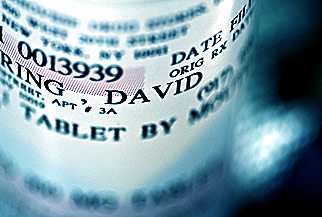Michigan State product protection program crosses boundaries to attack counterfeiting
March 11, 2015


Prescription drug label
Michigan State University has been involved with online learning for almost 10 years. Specifically the Food Safety, Criminal Justice, Public Health, and Packaging programs have had successful online Master’s degree programs that are doing nothing but growing. In addition to innovating in the method of delivery, MSU is innovating in the development of interdisciplinary programs that address extremely complex emerging risks.
One of these programs addresses anti-counterfeit strategy, which involves the disciplines of criminal justice, public health, packaging, supply chain, procurement, social anthropology, political science, engineering, business, economics, consumer behavior, intellectual property rights law, medicine and nursing, among others.
In 2004, MSU began this interdisciplinary route when the Packaging for Food Safety course was developed for the online Master’s in Food Safety program. In 2007, the program added the Anti-Counterfeit and Product Protection online graduate course. The course was conceived as industry and agencies were engaging MSU to move beyond just researching the topic, but to create curriculum and even a new academic discipline. MSU now has a certificate in Product Protection and will have a certificate in Anti-Counterfeit Strategy in 2011. The core Anti-Counterfeit and Product Protection course is also the cornerstone for the MSU Public Health Program certificate in Counterfeit Medicines.
“We developed the Public Health Certificate in Counterfeit Medicines around the core Anti-Counterfeit and Product Protection course to provide students with a holistic, all-encompassing foundation,” says lead instructor Doug Moyer.
The director of the Program in Public Health (in the College of Human Medicine), Dr. Michael Rip adds, “We are making an intentional effort to create an extremely interdisciplinary approach, which is critical to understand the underlying drivers before we look at solutions. This is not a challenge to the way we work but it enhances our efficiency in dealing with the travesty that is counterfeit medicines.”
The course student base has expanded to include product protection directors and U.S. agency leaders to the point that in 2010, MSU has 20 officials from the food and drug administration of a non-U.S. country. We are educating the anti-counterfeit leaders of industry and now of countries.
When we teach or work with packaging component suppliers, there is often a concern that the broad approach minimizes the role of packaging, but that couldn’t be farther from the truth. Actually, our entire program is based on key concepts that were established in packaging and even here in Packaging Digest (see Susan McNeely, Selecting Brand-Security Technology Suppliers, March 2007). Gone are the days when the brand owners were clueless and said, “Just give me an anti-counterfeit packaging component.”
The directors of product protection or anti-counterfeiting are being challenged to explain the problem and how a countermeasure actually helps reduce the risk. What we are finding is that the packaging manager’s drive is to understand the core issue, which is the basic fraud opportunity.
Beyond working with industry and expanding the discipline, MSU has become more involved in international and domestic policy and standards research. From an international perspective, we are involved in leading the International Standards Organization Technical Committee of Fraud Controls and Countermeasures (ISO TC 247), as well as the World Health Organization. Domestically, we are actively involved with the full range of agencies working in both product protection and intellectual property rights enforcement. These engagements are key to helping packaging managers make and defend anti-counterfeit strategy decisions.
MSU takes the online learning opportunity to both provide the basic understanding of the root problem, but also to learn from our students about the cutting-edge risk management and technology implementation. The research feeds the teaching, which applies to the outreach, which feeds the research. We support packaging managers in their decision-making by bringing in criminology and the behavioral sciences when we focus on the long studied concepts of rational choice theory and situational crime prevention—the chemistry of the crime.
With counterfeiting, we are in a chess match with the criminals. In everything we do, we ask, “Are we disrupting the chemistry of the crime?”
For further information, contact John Spink, Ph.D. in the MSU Anti-Counterfeiting and Product Protection Program (A-CAPPP) in the School of Criminal Justice, at Michigan State University, 517/884-0520, [email protected], www.A-CAPPP.MSU.edu
Photo by CarbonNYC
.
About the Author(s)
You May Also Like


